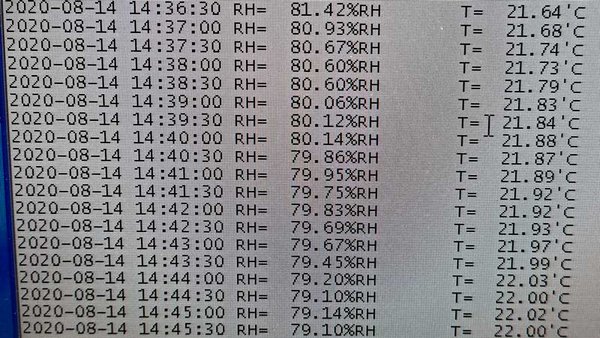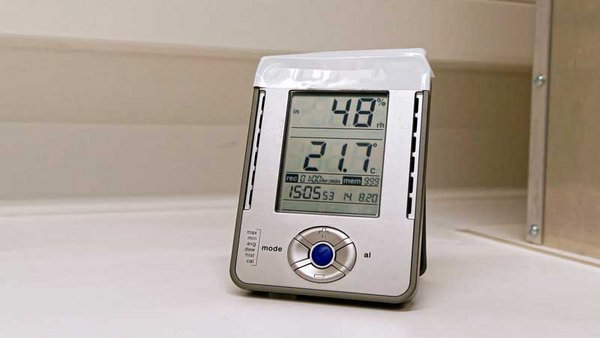Coronavirus SARS-CoV-2 spreads more indoors at low humidity.
Leipzig, 20.08.2020
Indian-German research team recommends at least 40 percent humidity in public buildings
Leipzig/New Delhi. The airborne transmission of the coronavirus SARS-CoV-2 via aerosol particles in indoor environment seems to be strongly influenced by relative humidity. This is the conclusion drawn by researchers from the Leibniz Institute for Tropospheric Research (TROPOS) in Leipzig and the CSIR National Physical Laboratory in New Delhi from the analysis of 10 most relevant international studies on the subject. Therefore, they recommend controlling the indoor air in addition to the usual measures such as social distancing and masks. A relative humidity of 40 to 60 percent could reduce the spread of the viruses and their absorption through the nasal mucous membrane. To contain the COVID-19 pandemic, it is therefore extremely important to implement standards for indoor air humidity in rooms with many people, such as hospitals, open-plan offices or public transport, writes the research team in the scientific journal Aerosol and Air Quality Research.
According to the WHO, the coronavirus SARS-CoV-2 has led to at least 21 million infected persons and over 750,000 deaths worldwide in over half a year. The health and economic effects of the pandemic pose major social challenges for practically all countries. Worldwide, therefore, ways are being sought to stem the spread of the virus in order to avoid drastic measures such as lockdowns and contact restrictions. For a long time, the main transmission route of viral droplets was considered to be direct human-to-human contact, because of infected people sneezing or coughing and secreting the virus. Because these drops are relatively large and heavy, they fall very quickly to the ground and can only cover very short distances in the air. The recommendation to keep a minimum distance of 1.5m to 2m (social distancing) is based on this assumption. Recently, however, COVID-19 outbreaks have also been recorded, which seem to be due to the simultaneous presence of many people in one room (choir rehearsals, slaughterhouses, etc.). A safety distance of 1.5m is apparently not sufficient when infected and healthy people are together in one room for a long time. For example, Dutch researchers have now been able to prove that tiny drops of 5 micrometres in diameter, such as those produced when speaking, can float in the air for up to 9 minutes. In July, 239 scientists from 32 countries - including the chemist Prof. Hartmut Herrmann from TROPOS - therefore appealed to the World Health Organization (WHO) to focus more closely on the long-lived infectious particles suspended in the air. In order to contain the spread via the aerosol particles floating in the air, the researchers recommend not only continuing to wear masks but also, and above all, good indoor ventilation.
An Indo-German research team is now pointing out another aspect that has received little attention so far and could become particularly important in the next flu season: Indoor humidity. Physicists at the Leibniz Institute for Tropospheric Research (TROPOS) in Leipzig and the CSIR National Physical Laboratory in New Delhi have been studying the physical properties of aerosol particles for years in order to better estimate their effects on air quality or cloud formation. "In aerosol research, it has long been known that air humidity plays a major role: The more humid the air is, the more water adheres to the particles and so they can grow faster. So, we were curious: what studies have already been conducted on this," explains Dr. Ajit Ahlawat from TROPOS.
Therefore, they evaluated a total of 10 most relevant international studies between 2007 and 2020 by other researchers who investigated the influence of humidity on survival, spread and infection with the pathogens of influenza and the corona viruses SARS-CoV-1, MERS and SARS-CoV-2. Result: Air humidity influences the spread of corona viruses indoors in three different ways: (a) the behaviour of microorganisms within the virus droplets, (b) the survival or inactivation of the virus on the surfaces, and (c) the role of dry indoor air in the airborne transmission of viruses. Although, low humidity causes the droplets containing viruses to dry out more quickly, the survivability of the viruses still seems to remain high. The team concludes that other processes are more important for infection: "If the relative humidity of indoor air is below 40 percent, the particles emitted by infected people absorb less water, remain lighter, fly further through the room and are more likely to be inhaled by healthy people. In addition, dry air also makes the mucous membranes in our noses dry and more permeable to viruses," summarizes Dr. Ajit Ahlawat.
The new findings are particularly important for the upcoming winter season in the northern hemisphere, when millions of people will be staying in heated rooms. "Heating the fresh air also ensures that it dries. In cold and temperate climate zones, therefore, the indoor climate is usually very dry during the heating season. This could encourage the spread of corona viruses," warns Prof. Alfred Wiedensohler of TROPOS. The air humidity determines how much water a particle can bind. At higher air humidity, the surface of the particles changes considerably: a kind of water bubble forms - a miniature ecosystem with chemical reactions. The liquid water content of aerosols plays an important role in many processes in the atmosphere, as it influences the optical properties, leading for example to haze or altered effects of aerosols on the climate.
At a higher humidity, the droplets grow faster, fall to the ground earlier and can be inhaled less by healthy people. "A humidity level of at least 40 percent in public buildings and local transport would therefore not only reduce the effects of COVID-19, but also of other viral diseases such as seasonal flu. Authorities should include the humidity factor in future indoor guidelines," demands Dr. Sumit Kumar Mishra of CSIR - National Physical Laboratory in New Delhi. For countries in cool climates, the researchers recommend a minimum indoor humidity. Countries in tropical and hot climates, on the other hand, should take care that indoor rooms are not extremely undercooled by air conditioning systems. When air is extremely cooled, it dries out the air and the particles in it, making people inside the room feel comfortable. But the dry particles will remain in the air for longer duration.
From a researchers’ point of view, more attention should be paid to indoor air to prevent future outbreaks of viral disease. The moisture content of indoor air is an important aspect but not the only one. Fresh air from outside can also reduce the risk of transmission. And of course, the measures already known and practised: Keep social distancing, having as few people per room volume as possible, and wearing masks. The lowest risk of infection still where there are no viruses in the air. Tilo Arnhold
Publication:
Ahlawat, A., Wiedensohler, A. and Mishra, S.K. (2020). An Overview on the Role of Relative Humidity in Airborne Transmission of SARS-CoV-2 in Indoor Environments. Aerosol Air Qual. Res. (in press). DOI: 10.4209/aaqr.2020.06.0302
https://doi.org/10.4209/aaqr.2020.06.0302
Media contacts:
Prof Alfred Wiedensohler (de.+en.)
Head of the Department Experimental Aerosol & Cloud Microphysics
Leibniz Institute for Tropospheric Research (TROPOS)
Phone +49 341 2717- 7062
https://www.tropos.de/en/institute/about-us/employees/alfred-wiedensohler
and
Dr. Ajit Ahlawat (en.)
Scientific staff (Post-Doc), Department Experimental Aerosol & Cloud Microphysics
Leibniz Institute for Tropospheric Research (TROPOS)
https://www.tropos.de/en/institute/about-us/employees
www.tropos.de/institut/abteilungen/experimentelle-aerosol-und-wolkenmikrophysik/ag-troposphaerisches-aerosol
and
Dr. Sumit Kumar Mishra (en.)
Scientist, Environmental Sciences and Biomedical Metrology Division,
CSIR - National Physical Laboratory
Phone +91-11-45609387
http://www.nplindia.in/users/mishrasknplindiaorg
or
Tilo Arnhold
Public Relations at the Leibniz Institute for Tropospheric Research (TROPOS), Leipzig, Germany
Phone: +49-341-2717-7189
https://www.tropos.de/en/current-issues/press-releases
Links:
Support for the appeal of protective measures against the airborne spread of Covid-19
https://www.tropos.de/en/current-issues/press-releases/statements/unterstuetzung-appell-bezuegich-covid-19
Exposure to ultrafine aerosol particles in German homes depends primarily on the people themselves (press release, 19 May 2020)
https://www.tropos.de/en/current-issues/press-releases/details/belastung-durch-ultrafeinstaub-in-deutschen-wohnungen-haengt-vor-allem-von-den-menschen-selber-ab
TROPOS long-term studies for particulate air quality
https://www.tropos.de/en/institute/departments/experimental-aerosol-and-cloud-microphysics/tropospheric-aerosols-workgroup/ultrafine-particles-and-air-quality
UBA Indoor Air Hygiene Commission
https://www.umweltbundesamt.de/en/topics/health/commissions-working-groups/indoor-air-hygiene-commission
The Leibniz-Institute for Tropospheric Research (TROPOS) is member of the Leibniz Association, which connects 96 independent research institutions that range in focus from the natural, engineering and environmental sciences via economics, spatial and social sciences to the humanities. Leibniz Institutes address issues of social, economic and ecological relevance. They conduct knowledge-driven and applied basic research, maintain scientific infrastructure and provide research-based services.
The Leibniz Association identifies focus areas for knowledge transfer to policy-makers, academia, business and the public. Leibniz institutions collaborate intensively with universities – in the form of “Leibniz ScienceCampi” (thematic partnerships between university and non-university research institutes), for example – as well as with industry and other partners at home and abroad.
They are subject to an independent evaluation procedure that is unparalleled in its transparency. Due to the importance of the institutions for the country as a whole, they are funded jointly by the Federation and the Länder, employing some 20,000 individuals, including 10,000 researchers.
The entire budget of all the institutes is approximately 1.9 billion Euros. They are financed jointly by the Federal Government and the Länder. The basic funding of the Leibniz Institute for Tropospheric Research (TROPOS) is therefore financed by the Federal Ministry of Education and Research (BMBF) and the Saxon State Ministry of Science and the Arts (SMWK). The Institute is co-financed with tax revenues on the basis of the budget approved by the Saxon State Parliament.
https://www.leibniz-gemeinschaft.de/en/home/
https://www.bmbf.de/en/index.html
https://www.smwk.sachsen.de/


